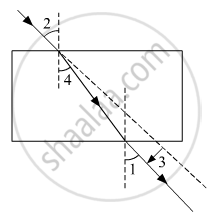Advertisements
Advertisements
प्रश्न
How does refraction take place in the atmosphere? Why do stars twinkle but not the planets?
उत्तर
There are several layers present in the atmosphere. The upper layer is optically rare, but the bottom layer is optically denser. When light passes through thicker and denser layers of the atmosphere, it bends towards the normal. As the stars are present very far away from us, the light coming from them get refracted multiple times and that results in the twinkling of the stars.
The planets are present much closer to the earth as compared to stars which make planets look like an extended source of light, not like a point-sized source of light as stars appear. This makes planets look stationary, not twinkling like stars.
APPEARS IN
संबंधित प्रश्न
What is atmospheric refraction? Use this phenomenon to explain the following natural events:
Advanced sun-rise and delayed sun-set.
Draw diagrams to illustrate your answers.
Explain why the planets do not twinkle.
The correct sequencing of angle of incidence, angle of emergence, angle of refraction and lateral displacement shown in the following diagram by digits 1, 2, 3 and 4 is:

(a) 2, 4, 1, 3
(b) 2, 1, 4, 3
(c) 1, 2, 4, 3
(d) 2, 1, 3, 4
Atmospheric refraction causes advance sunrise and delayed sunset. By how much time is:
sunset delayed?
Fill in the following blank with suitable word:
We can see the sun about ................ minutes before the actual sunrise and about ................ minutes after the actual sunset because of atmospheric ................
As light from a far off star comes down towards the earth:
(a) it bends away from the normal
(b) it bends towards the normal
(c) it does not bend at all
(d) it is reflected back
We know that light refracts (or bends) when it goes from one medium to another. Now, the atmosphere contains only air. Then how does light get refracted on passing through only air in the atmosphere?
The stars appear higher from horizon than they actually are. Explain why it is so.
Explain why the planets do not twinkle but the stars twinkle.
The air layer of the atmosphere whose temperature is less than the hot layer behave as optically:
